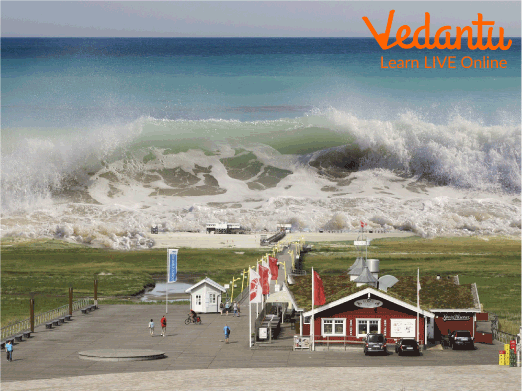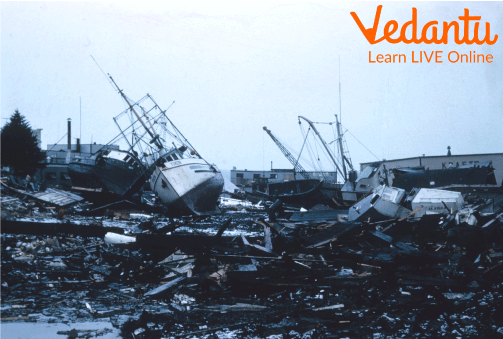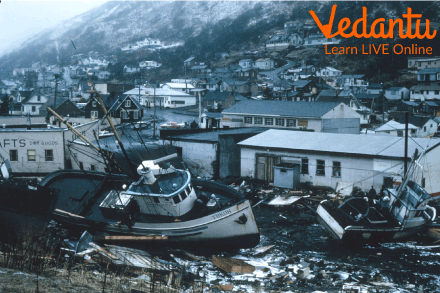




What Happens During Tsunamis?
Once the water is shaken by an earthquake or other event, large waves propagate from the point where the water previously moved. These waves can travel quickly and over very long distances. Some tsunamis have been known to travel thousands of miles across the ocean and travel at speeds of up to 500 mph.
As waves travel through deeper parts of the ocean, their summits are usually small, only a few feet tall. This makes tsunamis difficult to detect because they are not necessarily visible in the deep ocean. When waves approach land and shallow water, they pile up and increase in height. On the beach, a trough of the wave may be visible. This will cause a decrease in the shoreline. Water can seep for some distance. This can be dangerous as people may be tempted to hang out in an open area. When the wave hits the shore, it will usually be a long wall of water. The water would sometimes, for some distance, run inland with great speed and force.

Tsunami
10 Facts About Tsunamis
- A tsunami is a series of very large ocean waves usually caused by an underwater earthquake.
- The word “tsunami” comes from Japanese and means “harbor wave.”
- Most tsunamis start in the Pacific Ocean because it has many active earthquake zones.
- When a tsunami begins, the sea near the shore may suddenly move back before the big waves arrive.
- Tsunami waves can travel very fast almost as fast as an airplane.
- Even small-looking tsunami waves can carry huge energy and cause a lot of damage.
- Tsunamis can travel across entire oceans and hit distant countries hours after the earthquake.
- Warning systems in coastal areas can help people move to higher ground in time.
- After a tsunami, clean water and food often become hard to find, and rescue teams help those affected.
- Protecting nature like mangrove forests and coral reefs can reduce the power of tsunami waves near the coast.

Tsunami Can Cause Big Damage.
Tsunami Survival Tips
The International Tsunami Warning System is a system that enables geological activity to be studied and monitored. Based on this prior information, necessary steps are taken so that it can cause less damage.
The velocity of waves can be reduced by planting tidal trees in coastal areas.
Usually, the population of fishermen is more in the coastal parts and they are also affected the most. Therefore, they should be trained to cooperate in rescue work and law and order to protect them from their influence.
If you get caught in the water in a tsunami, then catch anything like trees floating in the water and do not panic at all.
You have to go to the rescue teams like doctors, ambulance police etc. So you must remember their contact numbers.
Never watch the waves coming into the sea close by, otherwise, it can prove to be fatal.
After the tsunami, the government and various departments like health, economics, welfare, electricity, irrigation, etc. should carry out relief work in tsunami-affected areas.

Tsunami-affected Areas
Fun Facts About Tsunamis
Tsunamis are sometimes called tidal waves, which have nothing to do with ocean tides.
The first wave of a tsunami may not be the biggest.
The word 'tsunami' means 'harbour wave' in Japanese.
The warning system in the Pacific is called the DART system, which stands for Deep-Ocean Assessment and Tsunami Reporting.
In this article, we have studied many things about Tsunamis. Now, you must have understood what is called Tsunami and its facts, causes, and many things related to the tsunami.
FAQs on Interesting Facts About Tsunamis
1. What are five simple facts about tsunamis
Tsunamis are large ocean waves usually caused by underwater earthquakes They can travel very fast across oceans The first wave is not always the biggest Coastal areas may flood quickly after the waves hit and warning systems help people move to safety
2. When did the Disaster Management Act come into force in India?
In 2005, the Disaster Management Act came into force in India.
3. When was India affected by the Tsunami?
The first Tsunami that affected India was on 26 December 2004.
4. How long can a tsunami last?
A tsunami can last for several hours in some cases even longer The waves can keep coming in intervals of minutes apart before the ocean becomes calm again.
5. What are some of the biggest facts about tsunamis
Tsunamis can cross entire oceans reaching thousands of kilometers away The waves can travel as fast as 800 kilometers per hour and rise higher than 30 meters near the shore.









